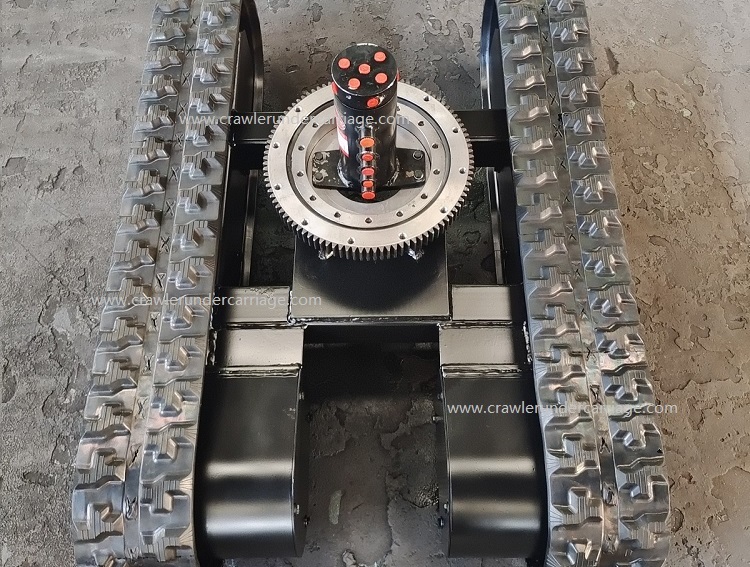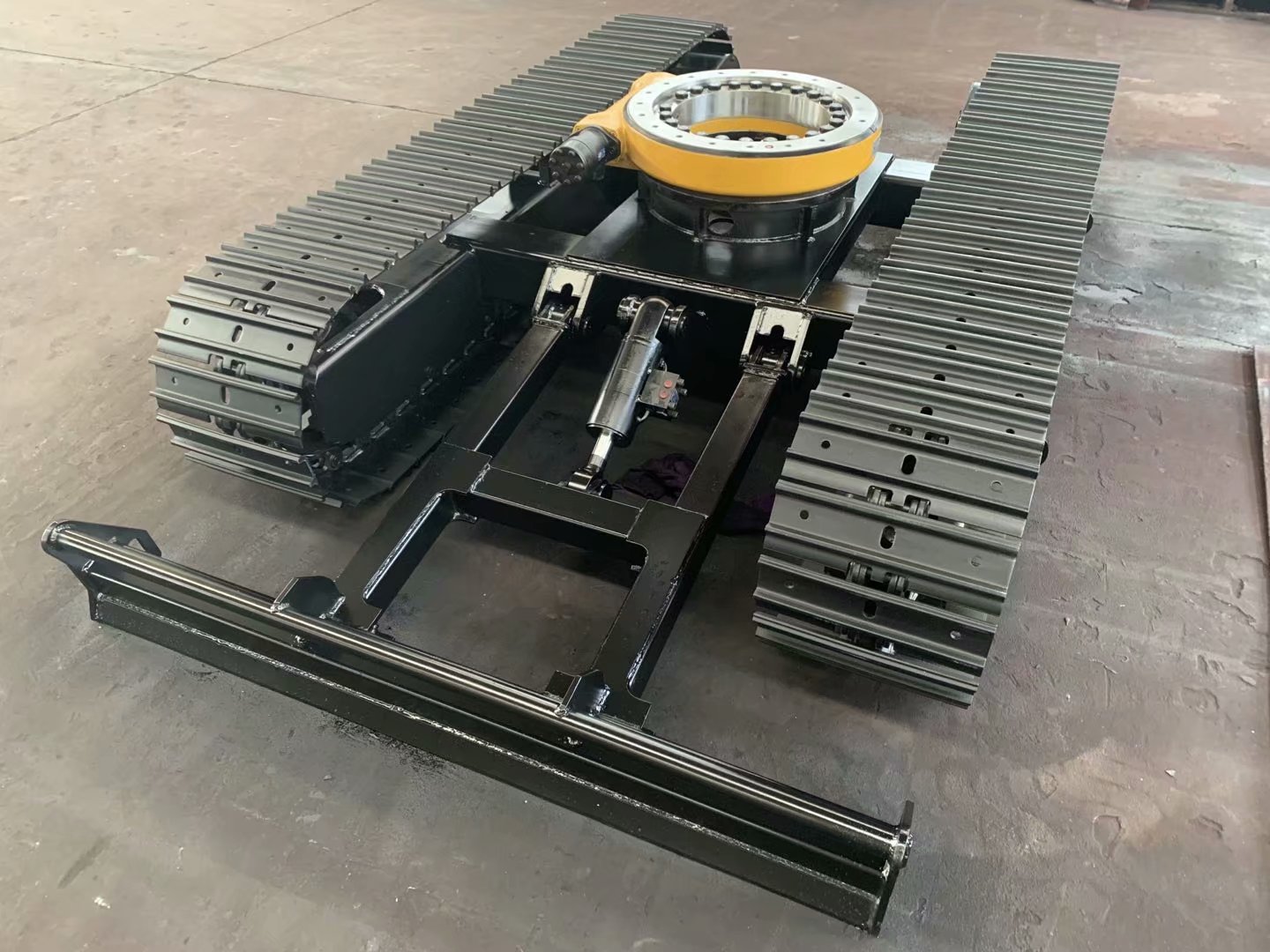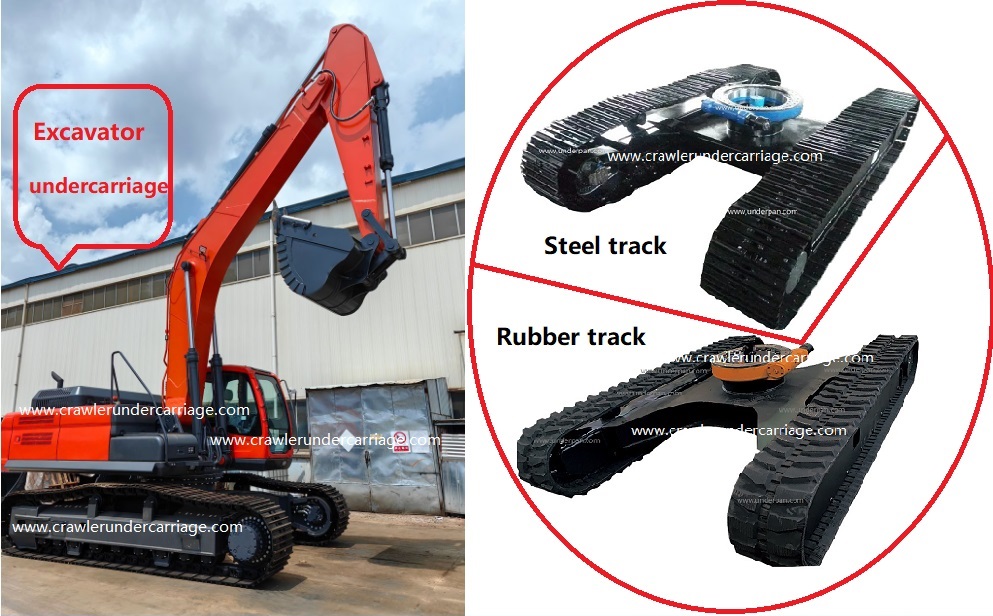The undercarriage chassis with a rotary device is one of the core designs for excavators to achieve efficient and flexible operations. It organically combines the upper working device (boom, stick, bucket, etc.) with the lower traveling mechanism (tracks or tires) and enables 360° rotation through the slewing bearing and drive system, thereby significantly expanding the working range. The following is a detailed analysis of its specific applications and advantages:
I. Structural Composition of the Rotary undercarriage
1. Rotary Bearing
- Large ball or roller bearings that connect the upper frame (rotating part) with the lower frame (chassis), bearing axial, radial forces, and overturning moments.
- Common types: single-row four-point contact ball bearings (lightweight), crossed roller bearings (heavy-duty).
2. Rotary Drive System
- Hydraulic motor: drives the rotary bearing gear through a reducer to achieve smooth rotation (mainstream solution).
- Electric motor: applied in electric excavators, reducing hydraulic losses and providing faster response.
3. Reinforced Undercarriage Design
- A strengthened steel structure undercarriage frame to ensure torsional stiffness and stability during slewing.
- Track-type undercarriage usually require a wider track gauge, while tire-type chassis need to be equipped with hydraulic outriggers to balance the slewing moment.
II. Key Improvements to Excavator Performance
1. Operational Flexibility
- 360° Unobstructed Operation: No need to move the chassis to cover all surrounding areas, suitable for narrow spaces (such as urban construction, pipeline excavation).
- Precise Positioning: Proportional valve control of slewing speed enables millimeter-level positioning of the bucket (such as foundation pit finishing).
2. Work Efficiency Optimization
- Reduced Movement Frequency: Traditional fixed-arm excavators need to frequently adjust positions, while the rotary undercarriage chassis can switch working faces by rotating, saving time.
- Coordinated Compound Actions: Slewing and boom/stick linkage control (such as "swinging" actions) enhance cycle operation efficiency.
3. Stability and Safety
- Center of Gravity Management: Dynamic loads during slewing are distributed through the undercarriage, and counterweight design prevents overturning (such as rear-mounted counterweights on mining excavators).
- Anti-vibration Design: Inertia during slewing braking is buffered by the undercarriage, reducing structural impact.
4. Multi-functional Expansion
- Quick-change Interfaces: The slewing chassis allows for rapid replacement of different attachments (such as hydraulic hammers, grabs, etc.), adapting to diverse scenarios.
- Integration of Auxiliary Devices: Such as rotating hydraulic lines, supporting attachments that require continuous rotation (such as augers).
III. Typical Application Scenarios
1. Construction Sites
- Completing multiple tasks such as excavation, loading, and leveling within a limited space, avoiding frequent chassis movement and collisions with obstacles.
2. Mining
- Large-tonnage excavators with high-strength slewing chassis to withstand heavy-load excavation and long-term continuous rotation.
3. Emergency Rescue
- Quick slewing to adjust the working direction, combined with grabs or shears to clear debris.
4. Agriculture and Forestry
- The rotating undercarriage facilitates the grasping and stacking of wood or deep digging of tree pits.
IV. Technological Development Trends
1. Intelligent Rotary Control
- Monitoring rotary angle and speed through IMU (Inertial Measurement Unit), automatically restricting dangerous actions (such as slewing on slopes).
2. Hybrid Power Rotary System
- Electric rotary motors recover braking energy, reducing fuel consumption (such as Komatsu HB365 hybrid excavator).
3. Balance of Lightweight and Durability
- Using high-strength steel or composite materials to reduce undercarriage weight while optimizing rotary bearing sealing (dust-proof, water-proof).
V. Maintenance Points
- Regular lubrication of the rotary bearing: Prevents raceway wear causing undercarriage noise or shaking.
- Check bolt preload: Loosening of the bolts connecting the slewing bearing and chassis can cause structural risks.
- Monitor hydraulic oil cleanliness: Contamination can lead to rotary motor damage and affect undercarriage drive performance.
Summary
The undercarriage chassis with a rotating mechanism is a distinctive design that sets excavators apart from other construction machinery. Through the mechanism of "fixed undercarriage and rotating upper body", it achieves an efficient, flexible and safe operation mode. In the future, with the penetration of electrification and intelligent technologies, the rotating undercarriage will further develop towards energy conservation, precision and durability, becoming a core link in the technological upgrade of excavators.









